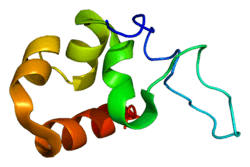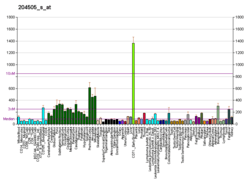EPB49
Dematin is a protein that in humans is encoded by the EPB49 gene.[5][6][7]
References
- 1 2 3 GRCh38: Ensembl release 89: ENSG00000158856 - Ensembl, May 2017
- 1 2 3 GRCm38: Ensembl release 89: ENSMUSG00000022099 - Ensembl, May 2017
- ↑ "Human PubMed Reference:".
- ↑ "Mouse PubMed Reference:".
- ↑ Rana AP, Ruff P, Maalouf GJ, Speicher DW, Chishti AH (Aug 1993). "Cloning of human erythroid dematin reveals another member of the villin family". Proc Natl Acad Sci U S A. 90 (14): 6651–5. doi:10.1073/pnas.90.14.6651. PMC 46990. PMID 8341682.
- ↑ Khanna R, Chang SH, Andrabi S, Azam M, Kim A, Rivera A, Brugnara C, Low PS, Liu SC, Chishti AH (May 2002). "Headpiece domain of dematin is required for the stability of the erythrocyte membrane". Proc Natl Acad Sci U S A. 99 (10): 6637–42. doi:10.1073/pnas.052155999. PMC 124455. PMID 12011427.
- ↑ "Entrez Gene: EPB49 erythrocyte membrane protein band 4.9 (dematin)".
Further reading
- Azim AC, Knoll JH, Beggs AH, Chishti AH (1995). "Isoform cloning, actin binding, and chromosomal localization of human erythroid dematin, a member of the villin superfamily". J. Biol. Chem. 270 (29): 17407–13. doi:10.1074/jbc.270.29.17407. PMID 7615546.
- Azim AC, Marfatia SM, Korsgren C, et al. (1996). "Human erythrocyte dematin and protein 4.2 (pallidin) are ATP binding proteins". Biochemistry. 35 (9): 3001–6. doi:10.1021/bi951745y. PMID 8608138.
- Strausberg RL, Feingold EA, Grouse LH, et al. (2003). "Generation and initial analysis of more than 15,000 full-length human and mouse cDNA sequences". Proc. Natl. Acad. Sci. U.S.A. 99 (26): 16899–903. doi:10.1073/pnas.242603899. PMC 139241. PMID 12477932.
- Millar JK, Christie S, Porteous DJ (2004). "Yeast two-hybrid screens implicate DISC1 in brain development and function". Biochem. Biophys. Res. Commun. 311 (4): 1019–25. doi:10.1016/j.bbrc.2003.10.101. PMID 14623284.
- Frank BS, Vardar D, Chishti AH, McKnight CJ (2004). "The NMR structure of dematin headpiece reveals a dynamic loop that is conformationally altered upon phosphorylation at a distal site". J. Biol. Chem. 279 (9): 7909–16. doi:10.1074/jbc.M310524200. PMID 14660664.
- Ota T, Suzuki Y, Nishikawa T, et al. (2004). "Complete sequencing and characterization of 21,243 full-length human cDNAs". Nat. Genet. 36 (1): 40–5. doi:10.1038/ng1285. PMID 14702039.
- Gerhard DS, Wagner L, Feingold EA, et al. (2004). "The Status, Quality, and Expansion of the NIH Full-Length cDNA Project: The Mammalian Gene Collection (MGC)". Genome Res. 14 (10B): 2121–7. doi:10.1101/gr.2596504. PMC 528928. PMID 15489334.
- Vermeulen W, Van Troys M, Bourry D, et al. (2006). "Identification of the PXW sequence as a structural gatekeeper of the headpiece C-terminal subdomain fold". J. Mol. Biol. 359 (5): 1277–92. doi:10.1016/j.jmb.2006.04.042. PMID 16697408.
This article is issued from
Wikipedia.
The text is licensed under Creative Commons - Attribution - Sharealike.
Additional terms may apply for the media files.







